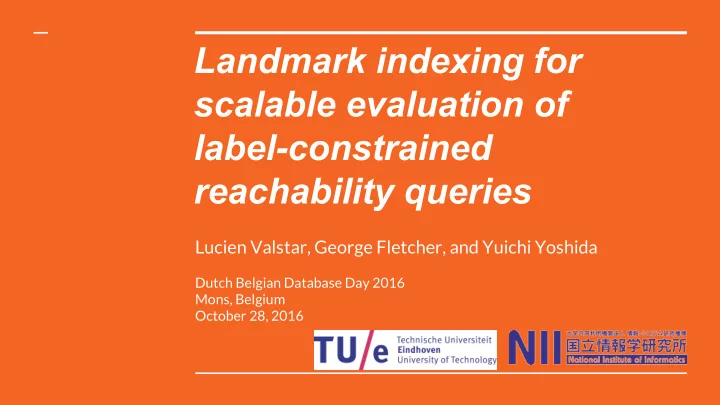

Landmark indexing for scalable evaluation of label-constrained reachability queries Lucien Valstar, George Fletcher, and Yuichi Yoshida Dutch Belgian Database Day 2016 Mons, Belgium October 28, 2016
Introduction & problem statement
Introduction - Web and many other contemporary applications are generating huge amounts of graph data. Many of these are edge-labelled. - Examples: - RDF, semantic web - knowledge graphs - social networks, - road networks - biological networks
Example: social network - LCR-query: can v 1 reach v 3 using only edges of the label { friendOf } ? - No, hence query ( v 1 , v 3 , { friendOf } ) is false. - Can v 1 reach v 3 using only edges of the labels { friendOf , likes } ? - Yes, hence the query ( v 1 , v 3 , { friendOf , likes } ) is true.
Solutions
Breadth-first search - Given a query ( v , w , L ) we wish to find out whether the query is a true- or a false-query. - BFS explores the graph looking for w using only edges with a label l ∈ L . - It has the ‘maximum’ query answering time, but the ‘minimum’ index construction time and index size.
Landmarked-index (LI): our basic idea - Building a full index, i.e. for all vertices, takes too much time and memory, but can answer all queries immediately. - Hence we build an index for a subset of the vertices k ≤ n (called landmarks) of vertices: v 1 , … v k , where n is the number of nodes. - Build an index for each v 1 , … v k . - Use BFS as baseline and use v 1 , … v k to speed up the query answering.
Landmarked-index (LI+): extensions For large graphs we get that the ratio k / n gets lower. Because we use BFS as a baseline, we may experience two issues. 1) Reaching the landmarks may take a long time, hence we store some (say b ) label sets connecting non-landmarks with landmarks. 2) False queries are still slow with LI-approach. For each landmark v and a label set L * we store a subset of the vertices V * ⊆ V s.t. for all v * in V * we have that ( v , v * , L * ) is a true-query. This is used for pruning.
Experimental results
A few real datasets Dataset | V | | E | | L | k b soc-sign-epinions 131k 840k 8 1318 15 webGoogle 875k 5.1M 8 1751 15 4905 15 zhishihudong 2.4M 18.8M 8 wikiLinks (fr) 3M 102.3M 8 1738 20 - Used server with 258GB of memory and a 32-core 2.9Ghz processor - 3,000 true-queries - Set a 6-hour time limit and a 128GB memory limit - 3,000 false-queries - Method under study: LI+ - Single-threaded
Results on these graphs - Index size (MB) and construction time - Speed-up over BFS Dataset IS (MB) IT (s) True, False, | L |/4 True, | L |-2 False, | L |-2 | L |/4 soc-sign-epinions 1,159 114 1,733 1,894 4,213 2,958 webGoogle 27,117 4,691 4,181 5,908 4,385 20 zhishihudong 16,199 6,419 803 911 954 20 wikiLinks 98,125 24,873 10,200 9321 13,082 8036
Additional results - Similar results have been obtained on 23 real datasets - And on dozens of synthetic datasets where we varied: - graph size (5k up until 3.125M vertices) - label set distribution (exponential, normal, uniform) - label set size (from 8 to 16) - growth model (Erdos-Renyi, Preferential Attachment) - Other query related types (e.g. distance queries) were studied
Conclusion
Conclusion - Landmarked-Index is scalable w.r.t. the graph size. - Landmarked-Index leads to multiple orders of magnitude speed-ups, although there is some asymmetry still between true- and false-queries. - Future work: - Landmarked-Index could be a groundwork for other types of queries (distance queries, finding a witness, defining a budget per label,RPQ). - maintainability of the index.
Questions?
Related work - Zou et al. “ Efficient processing of label-constraint reachability queries in large graphs. ” is about LCR. - Bonchi et al. “ Distance oracles in edge-labeled graphs. ” is about LCR+distance. - For more on the LI-algorithm: https://www.youtube.com/watch?v=QKLtpoLdXfk
Recommend
More recommend